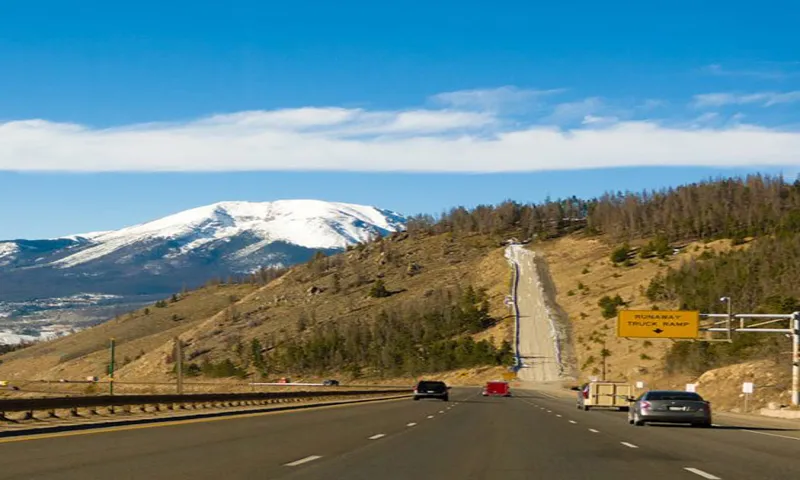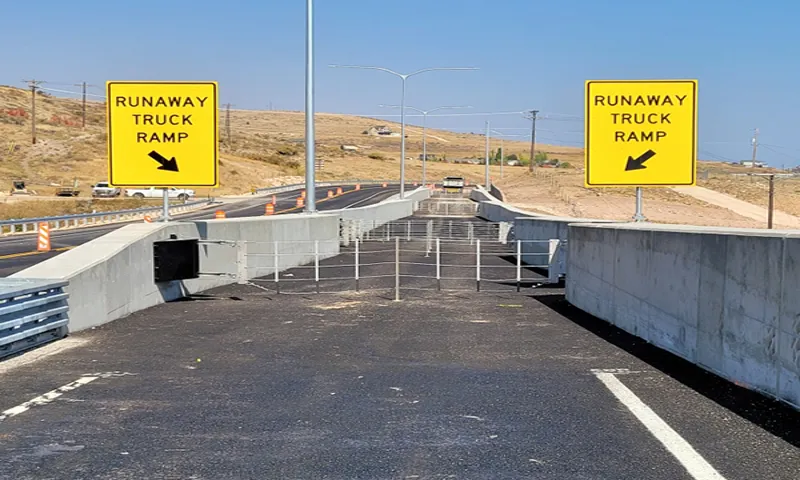Have you ever seen those long, steep, runaway truck ramps alongside highways and wondered what they were for? You know, the ones with deep gravel beds that abruptly end on an uphill slope. Those are called escape ramps, and they’re designed to stop large vehicles that have lost their brakes from careening down the highway and crashing into anything in their path. These ramps are essential safety features that can mean the difference between a catastrophic accident and a close call.
But how do they work? Let’s find out.
Table of Contents
Definition and Purpose
An escape ramp is a safety measure designed for vehicles, especially those traveling downhill on steep slopes. It is also known as a runaway truck ramp or emergency escape ramp. The purpose of an escape ramp is to slow down and stop runaway vehicles that have lost control of their speed, usually due to brake failure or driver error.
The ramp features a long inclined surface made of gravel, sand, or other soft materials that reduce the vehicle’s momentum and bring it to a safe stop. Escape ramps are strategically placed on highways and other steep roads to prevent accidents and save lives. The use of escape ramps should only be reserved for emergencies, and drivers should always take precautions to ensure their vehicles are in good condition and follow proper driving techniques to avoid runaway situations.
Definition of Escape Ramps
Escape ramps, also known as runaway truck ramps, are areas on the side of highways or mountainous roads designed to provide an escape route for large commercial vehicles that are experiencing brake failure or other mechanical problems that make it difficult for them to stop. These ramps consist of a long, upward sloping area made of gravel or other materials that provide resistance to the vehicle’s movement, causing it to slow down and eventually come to a stop. The purpose of escape ramps is to prevent accidents caused by out-of-control trucks colliding with other vehicles, buildings, or natural barriers.
They also protect the driver and the cargo by providing a safer alternative to crashing or tipping over. Escape ramps are strategically placed in areas where the probability of such an event occurring is high, such as steep downgrades or sharp curves. Proper maintenance and signage are crucial to ensure that drivers are aware of their location and use them effectively.

Purpose of Escape Ramps
Escape ramps are designed to save lives and prevent accidents by providing a way for vehicles to stop safely in the event of an emergency. These ramps are typically found on steep downhill sections of highways and are designed to allow vehicles to exit the roadway and come to a stop safely. They are typically made of sand, gravel, or other materials that allow for a controlled stop and are marked with reflective signs to make them easy to identify.
The purpose of escape ramps is to give drivers an emergency option if their brakes fail or they are unable to slow down quickly enough on steep descents, providing a safe alternative to potentially catastrophic accidents. So, if you ever find yourself descending a steep slope and your brakes fail, remember to use the escape ramp to bring your vehicle to a safe stop.
Types of Escape Ramps
“What is an escape ramp?” Well, an escape ramp is a designated area on a highway or mountain road that provides an opportunity for out-of-control vehicles to stop safely. There are different types of escape ramps available, depending on the terrain and the type of vehicle. The most common type is the “runaway truck ramp” which is typically used for heavy-duty vehicles like semi-trucks and trailers.
The runway truck ramp is usually located at the bottom of a steep slope to capture trucks that have lost control due to brake failure or any other mechanical failure. Another type of escape ramp is a “gravity escape ramp.” The gravity escape ramp is situated in a steep slope and uses the incline to slow down or stop the vehicle gradually.
For passenger cars, there is a specially designed “safety ramp” that directs the car to a side area where it can halt safely. It is set up either parallel to the road or at an angle of 90 degrees. The safety ramp can be found on winding mountain roads where drivers might lose control of their cars due to speed.
So, escape ramps are essential safety features that provide a way for vehicles to stop safely in an emergency situation, and they come in different designs and types to cater to different vehicles and terrain.
Gravity Escape Ramps
Gravity escape ramps are a vital safety feature on mountainous roads, offering truck drivers a way to quickly and safely stop their vehicles in case of brake failure. There are two types of escape ramps: arrester beds and escape lanes. Arrester beds are typically found at the bottom of a downhill section, where the ramp is filled with soft, crushable materials like gravel or sand.
Escape lanes, on the other hand, are typically found mid-hill, and feature a steep uphill incline to help slow down the vehicle. Both types of ramps are designed to minimize the damage caused by runaway trucks, and provide drivers with a last-ditch effort to avoid a serious accident. These ramps are an excellent example of how engineering can be used to protect drivers and other road users, and are a crucial element of any mountainous highway.
So next time you’re driving through the hills, take a moment to appreciate the gravity escape ramps dotting the landscape – they might just save your life.
Arrester Beds
When it comes to safety on the highways, arrester beds are an essential tool in preventing accidents and saving lives. But not all arrester beds are created equal, and different types of escape ramps are designed for specific purposes. For instance, some escape ramps are designed to slow down vehicles traveling at high speeds, while others are geared towards heavier vehicles like trucks and buses.
There are also escape ramps that are designed to help vehicles stop safely on steep grades, providing a crucial safety measure on treacherous mountain roads. No matter what the specific purpose, however, arrester beds play a crucial role in ensuring that drivers can stay safe on the highways, and they remain an essential part of transportation infrastructure all around the world. So, whether you’re driving through the mountains or cruising on the open highway, be sure to stay alert for any signs indicating the presence of an escape ramp – it could just save your life.
Engineer Ramps
Escape Ramps Engineer ramps, also known as escape ramps or runaway truck ramps, are crucial for preventing accidents involving runaway vehicles on steep hills or descent roads. These ramps are specialized areas alongside highways or roads designed to safely stop vehicles in emergency situations, such as brake failure or driver error. There are several types of engineer ramps, including escape, arrester beds, and truck arrester systems.
Escape ramps are typically made of gravel or other loose materials that allow the vehicle to safely come to a stop without causing any damage or harm to the driver or other vehicles. On the other hand, arrester beds and truck arrester systems are made of more specialized materials, such as steel pave, that offer higher levels of protection and are usually located at the end of ramps or hill descents. Overall, these engineer ramps are essential for ensuring driver safety and preventing potentially catastrophic accidents on our roads.
How Escape Ramps Work
Have you ever wondered what an escape ramp is and how it works? An escape ramp is a safety feature on steep roads that helps prevent accidents when trucks lose their brakes. When a truck loses its brakes, the driver can use the escape ramp to safely stop the vehicle. An escape ramp is usually made of gravel or sand, which allows the vehicle to come to a stop gradually.
The ramp is designed to provide enough friction that the vehicle can come to a complete stop without causing any harm to the driver or other motorists. It’s important to note that escape ramps aren’t just for trucks; any vehicle can use them in case of an emergency. If you’re ever driving on a steep road and see an escape ramp, keep in mind that it’s there to keep you and other motorists safe, so use it if you need to.
Principle of Operation
Escape ramps are designed to provide a safe and effective way for drivers to stop their vehicles when brakes fail or other emergencies arise while driving downhill. These ramps are strategically placed on steep slopes and are typically made of gravel or other loose material, which helps to slow down the vehicle gradually until it comes to a stop. When a driver realizes that their brakes are failing, they should immediately shift into a lower gear and begin to use their emergency brake.
If that is not enough, the driver should aim for the escape ramp, which is usually marked with signs to make it more visible. Once the vehicle reaches the ramp, the loose gravel will help to slow down the vehicle, allowing it to come to a safe stop. Escape ramps are critical in ensuring the safety of drivers and passengers, and it is vital that drivers understand how they work and where they are located.
So, if you are driving on a steep downhill road, make sure you know where the escape ramps are and be prepared to use them if necessary.
Factors Affecting the Effectiveness of Escape Ramps
Escape ramps are a crucial safety feature on highways that help to prevent accidents and save lives. These ramps work by providing a way for vehicles that have lost their brakes to safely slow down and come to a stop. The effectiveness of an escape ramp depends on several factors, including its design, placement, and the slope of the terrain.
A well-designed escape ramp should be long enough to slow the vehicle down gradually and give the driver time to regain control. It should also be located in a visible and accessible location. In addition, the slope of the terrain leading up to the escape ramp should be steep enough to slow the vehicle down, but not so steep that it causes the driver to lose control.
Lastly, regular maintenance and inspection is essential to ensure that the escape ramp is free of debris and in good working condition. Overall, escape ramps play a critical role in highway safety and serve as a last line of defense against catastrophic accidents.
Conclusion
So, there you have it folks – an escape ramp is kind of like a safety net for runaway vehicles that have lost control on steep slopes or mountainous terrain. Essentially, it’s a last line of defense against disaster, a tool that can help save lives and prevent catastrophic accidents. And just like how a fire extinguisher is a “must-have” item in the event of an emergency, an escape ramp is a vital piece of infrastructure that we hope we’ll never have to use, but are grateful to have when we need it – kind of like a superhero in the world of transportation safety.
“
FAQs
What is the purpose of an escape ramp?
An escape ramp is designed to provide a safe way for vehicles to stop in case their brakes fail while traveling downhill.
How does an escape ramp work?
An escape ramp uses a steep incline covered with gravel or sand to slow down a vehicle’s speed and bring it to a stop.
How often should escape ramps be inspected and maintained?
Escape ramps should be inspected and maintained regularly, according to state and federal regulations, to ensure they are safe and fully functional.
Are all escape ramps designed the same way?
No, escape ramps can vary in design depending on the terrain and location. Some may be longer or steeper than others, and some may use different materials to slow down vehicles.
Can any type of vehicle use an escape ramp?
Most escape ramps are designed for use by commercial trucks, but some may also be suitable for use by passenger cars and other vehicles.
How effective are escape ramps in preventing accidents?
When used correctly and maintained properly, escape ramps can be very effective in preventing accidents and saving lives.
What should drivers do if they need to use an escape ramp?
Drivers should follow the signs and instructions leading up to the escape ramp, enter the ramp at a safe speed, and steer straight ahead to come to a controlled stop. It is important to stay inside the vehicle and wait for assistance to arrive.



